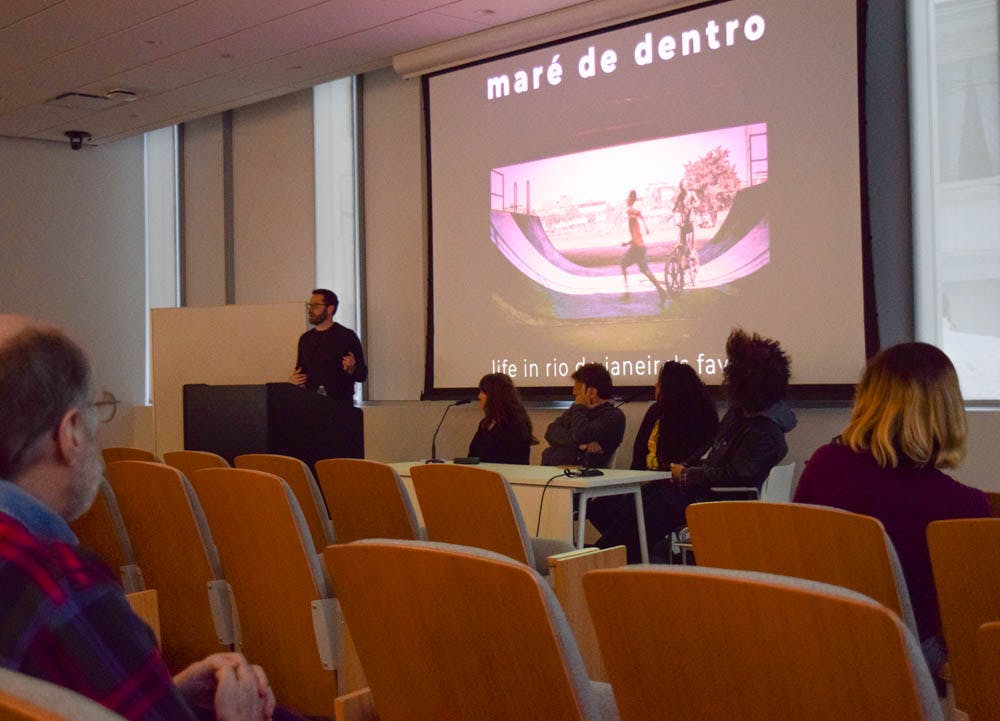Images of the favelas of Rio de Janeiro tend to look alike. In a panel Tuesday, video journalist Nadia Sussman observed that the most common photographs of the favelas, or shantytowns, depict “red brick homes stacked on top of one another and hand-strung electrical wires.”
But “Maré de Dentro,” a new exhibition of photographs and videos on display in Stephen Robert ’62 Hall through May 5, shows a different side of life in one favela complex, focusing on the private realities of the people who call Complexo de Maré their home.
The panel included perspectives from Sussman, whose videos are featured in the exhibition, as well as Henrique Gomes da Silva, Andreza Jorge and Antonello Veneri. Nicholas Barnes, a postdoctoral fellow at the Watson Institute for International and Public Affairs who spent 18 months living in Maré, moderated the event.
Each panelist spoke about their work in Maré, describing how depictions of the favela complex fail to adequately capture residents’ diverse identities. They also discussed the challenges Maré faces today, in part from its government and policies stemming from the war on drugs. The goal of “Maré de Dentro” is to replace some of the problematic portrayals of the favela complex with new images, photographs and videos of residents in their own spaces. These pieces, which aim to preserve respect and dignity for their subjects, are exhibited on the second and third floors of Stephen Robert ’62 Hall.
Jorge, a feminist, academic and resident of Maré, spoke about the kinds of knowledge cultivated over generations of people living in favela communities — a knowledge about how to survive and coexist in the complex. Speaking in Portuguese, which Barnes translated for attendees, Jorge recognized that such knowledge must be valued, but noted that, “There’s no way to give (the information) value; they already have value. And what they need is visibility.” “How can we produce greater visibility for this kind of knowledge?” she asked.
At 140,000 residents in only one and a half square miles, Maré is “more densely populated than anywhere in the United States, even Manhattan,” Barnes explained. Within the complex, there are internal borders delineated on cultural lines. Different areas are controlled by gangs and armed groups that serve as non-state governments. While the four armed groups that control Maré today have historically engaged in “incredible levels of violence,” they have also “developed a variety of different kinds of welfare and public goods that they provide to these communities,” Barnes said.
Gomes, an activist, Maré resident and contributor to the exhibited work, described Maré through Barnes’ translation as a community struggling with the war on drugs. The conflict is largely “an export of the United States’ own policies,” he said. “It’s not just a war on drugs, it’s a war against black, poor favela residents,” he added. Although he said that his awareness of the structural problems in Maré made him feel worse about the situation there, it also spurred him to start working with local NGOs and social movements, leading to his involvement with Sussman’s and Italian photojournalist Veneri’s projects.
Gomes described himself as a believer in “education of the local population,” adding that education will enable “changes (that) are not going to come from the outside. … They’re going to come from within the community itself.”
Gomes, like Jorge, grew up in Maré and has an intimate knowledge of some of the spaces and people within the communities. Both Sussman and Veneri credit Gomes with guiding their projects, giving them access they wouldn’t have had without his participation. “It’s really 50/50; it’s a collaborative project,” Veneri said of Gomes’ involvement with his photography.
Although the speakers spent much of their time discussing Maré’s often-overlooked cultural vibrancy, they also described the persistent violence that Maré residents face. Barnes, paraphrasing for Gomes, explained that in the 35 days he had been in the United States, “He hasn’t heard any gunshots, which is something he couldn’t say about his life in Brazil,” noting that Gomes struggled to make that observation without becoming emotional. Despite such hardship, Gomes said he is still “in love with” Maré.
Emotions occasionally ran high during the panel. Several of the speakers had worked closely with one another, and as Jorge thanked other members of the panel and the organizers for their work over the years, Barnes struggled to hold back tears while translating her words. “It is very emotional for me to be here,” Jorge said, “to express … the voice of people whose voices have existed but have seldom been heard.”





